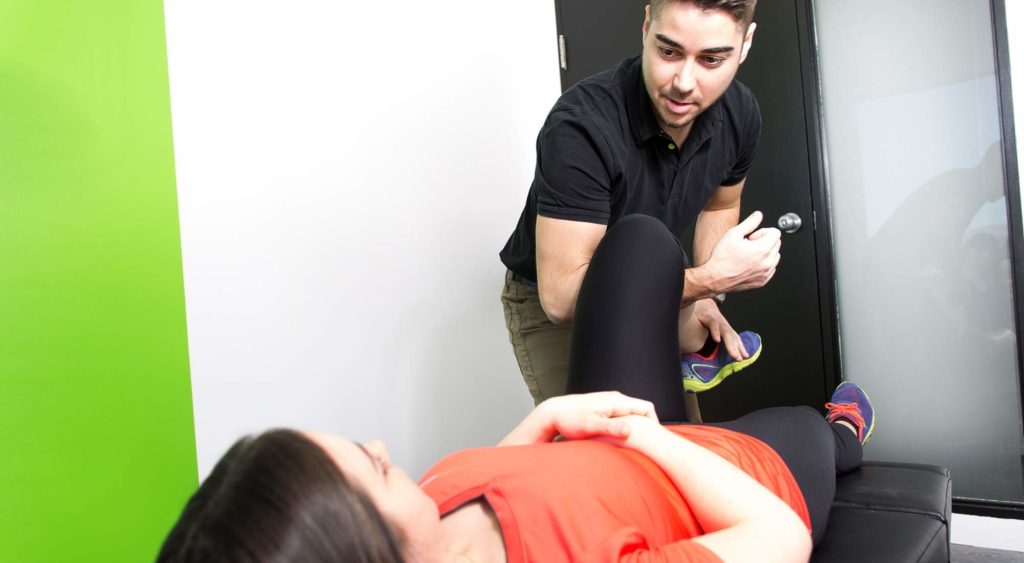Snapping Hip Physical Therapy

Physical Therapy for Snapping Hip – Information, Exercises, and More
You’re feeling pain in your hip. Not only pain though — you feel a snapping or popping sensation when you walk, run, stand up, or sit down.
Snapping hip is aptly named.
But it’s not just a feeling. You can actually hear it when this happens.
You do not have to live with the pain and discomfort of snapping hip. There are ways to find relief.
Read on to learn about:
- Types of snapping hip injuries
- What causes snapping hip syndrome
- How to treat snapping hip
- Snapping hip syndrome physical therapy
What is Snapping Hip?
Snapping hip syndrome — also known as coxa saltans is a hip disorder. Snapping hip is also sometimes referred to as dancer’s hip, due to its prevalence amongst dancers.
There are three main types of snapping hip syndrome:
- Internal
- External
- Intra-articular
Snapping hip syndrome can occur when hip muscles are excessively used and become:
- Fatigued
- Tight
- Swollen
Many cases of snapping hip syndrome are harmless but can increase the risk of joint damage. However, for athletes and dancers, this condition can cause significant pain and affect their level of performance.
Snapping hip syndrome is more common in athletes including:
- Dancers
- Gymnasts
- Runners
- Soccer players
- Equestrians
- Cyclists
Internal Snapping Hip
Internal snapping hip is the most common type of snapping hip. It occurs when your tendons slide over bone structures at the front of your hip joint. Pain is often felt near the groin.
Internal snapping hip can lead to a tear in the hip labrum.
External Snapping Hip
With external snapping hip, your tendon or muscle slides over the top of your thigh bone, or femur. The pain increases gradually. It may begin as an annoyance and worsen over time.
Patients often report that the hip feels as if it is about to pop out of its socket when it snaps during normal movements such as walking, running, or riding a bicycle.
External snapping hip syndrome is often associated with painful tenderness at the outside of the hip, which can be related to a type of hip bursitis called trochanteric bursitis.
External snapping hip syndrome is also associated with a tight IT band.
Intra-articular Snapping Hip
Intra-articular snapping hip is caused by an actual hip joint issue or injury, as opposed to an issue with a tendon or muscle and is the least common type of snapping hip syndrome.
Snapping hip due to a cartilage injury may develop suddenly, and may be caused by a fall or direct trauma to the hip. People with this type of injury may feel like their hip “locks up” and struggle with a limited range of motion.
What Causes Snapping Hip?
Snapping hip happens when your hip tendon or muscle slides over the bone. The muscle or tendon stretches then snaps when the tension is released during movement.
The underlying cause of your snapping hip depends on the type of snapping hip syndrome you have.
What Causes Internal Snapping Hip?
Internal snapping hip happens when your hip muscle or tendons slide over the front of your hip joint.
It is most often caused by overuse, repetitive flexion, and external rotation of the hip. Athletes with tight hip flexors and unbalanced strength in their pelvic, hip, and abdominal muscles are more prone to this condition.
What Causes External Snapping Hip?
You might experience external snapping hip if you have:
- Legs that are different lengths. Typically the longer leg is symptomatic.
- Tightness in your iliotibial band (IT band).
- Weakness in the hip abductors.
People with external snapping hip often experience tenderness on the outside of the hip. For example, it may be painful to lie on the affected hip.
What Causes Intra-articular Snapping Hip?
Intra-articular snapping hip happens when there is an actual hip joint injury rather than an issue with a muscle or tissue. Intra-articular snapping hip typically occurs after a hip trauma or injury.
Common causes of intra-articular snapping hip include:
- Articular cartilage injury
- Hip labral tear
- Fragments of a broken bone or loose tissue trapped between your hip’s ball and socket joint
Snapping Hip Symptoms
The main symptom of snapping hip syndrome comes directly from its name: snapping. When experiencing snapping hip, you might feel and even hear a snapping or popping when flexing your hip.
Other symptoms of snapping hip may include:
- Pain
- Inflammation
- Leg muscle weakness
- Swelling
- Difficulty with physical activity (walking, running, standing, etc.)
- A feeling that the hip is popping out of place
Snapping Hip Treatment
For minor snapping syndrome pain, try home treatments such as:
- Reducing or modifying activity
- Applying ice
- Using over-the-counter pain relievers
If home treatment is unsuccessful, physical therapy for snapping hip syndrome may be necessary.
Physical Therapy
Physical therapy can help relieve pain and repair snapping hip, especially when the emphasis is on:
- Stretching
- Strengthening
- Alignment

Physical Therapy For Snapping Hip – Will PT Help?
If rest and over-the-counter pain meds just aren’t cutting it, it’s time to turn to the professionals.
Physical therapists can help loosen tension in the hip, strengthen, and heal the muscles and tendons causing snapping hip.
To treat snapping hip, physical therapists may use some or all of these methods:
- Stretching – People with external hip snapping may benefit from stretching the IT band. People with inner hip snapping may benefit from stretching the hip flexors. Stretching helps to increase range of motion.
- Massage – Deep tissue massage can be helpful to reduce muscle tension and relieve pain and swelling caused by snapping hip syndrome.
- Strengthening exercises – Improving strength and power in the hip and core is key to treatment. Physical therapy exercises for snapping hip syndrome may be performed using resistance bands and free weights.
- Retraining – Especially for athletes, improving posture and assessing and modifying form dependent on their sport/activity can help prevent future injury.
Best Exercises For Snapping Hip
If you’re dealing with snapping hip syndrome and want to do something about it, you’ll need to perform exercises designed to increase flexibility as well as strengthen your hips and your core.
These exercises might include:
- Hip flexor stretch
- IT band stretch
- Clamshell exercise
- Glute bridges
You should consult with a physical therapist before starting any rehabilitative exercise programs.
How In Motion O.C. Can Help With Snapping Hip
Some people suffering from snapping hip choose to ignore it. Instead, they just deal with the pain.
But why? Why deal with pain or even inconvenient, annoying snapping in your hip.
You don’t have to. The physical therapists at In Motion O.C. can help.
Our team treats patients with hip injuries every single day and can design a specialized program to eliminate both the pain and that annoying snapping sound from your hip.
In Motion O.C. is the #1 rated physical therapy clinic on Yelp! and Google … and has the client testimonials to back it up.
*This information about physical therapy for snapping hip was reviewed by Dr Natalie Thomas, PT, DPT. If you have any questions, please don’t hesitate to contact us here.


